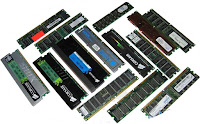 Memory is the core of logic – be it
human or machine, we can’t process anything unless we have a place to store
data, and that’s why memory has always been one of the core components in
computer design. When we talk about memory, most of us assume that we are
referring to RAM but that’s not how things actually started off.
Memory is the core of logic – be it
human or machine, we can’t process anything unless we have a place to store
data, and that’s why memory has always been one of the core components in
computer design. When we talk about memory, most of us assume that we are
referring to RAM but that’s not how things actually started off.
So today’s article would be covering
a brief history of RAM – how it evolved and what are the basic types of memory
we use today like DDR3 DRAM etc. I’d also be doing a comparison between some of
the future RAM technologies like Z-RAM or TT-RAM.
Early computers had a completely
different concept of memory from the one we use today. Most of the people (who
have studied Computer Science) would know that they employed an electrical
device called the Vacuum Tube – something similar to what we have in CRT
monitors and televisions. Then came the era of the transistors – which were
created by Bell Labs.
The transistor became the core
component of modern day memory, which started off with simple Latches – a
circuit configuration of transistors which can store 1 bit of data. Latches
evolved in Flip-Flops, which could be packed together to form Registers used in
most static memory cells today. Another approach tied a transistor with a
capacitor which allowed smaller and more compact dynamic memory.
Memory can easily be classified into
two major categories, Static RAM, and Dynamic RAM. Like I said above, Static
RAM uses a special arrangement of transistors to make a flip-flop, a type of
memory cell. One memory cell can store 1-bit of data. Most modern SRAM cells
are made of six CMOS transistors, and are the fastest type of memory on planet
Earth.
In contrast, Dynamic RAM lines up
one transistor with a capacitor to create an ultra compact memory cell. On the
flip side, the capacitor needs to be refreshed after a specific period to keep
the charge in the capacitor, which introduces a latency in memory access.
Something we refer to as memory timings.
While DRAM has an obvious size
advantage over SRAM, its speed can’t even get close to those offered by static
memory cells (because they don’t need to be refreshed and are always
available). That’s why faster memory is always made out of SRAM cells – like Registers
in the CPU and Caches used in numerous devices. But thanks to much higher space
requirements, SRAM is expensive and can’t be used as primary memory.
DRAM on the other hand is quite
dense, and therefore is employed in most places which don’t require
instantaneous access but large capacities – like main memory in a computer.
RAM can also be classified by
functionality. Everyone knows that electronic devices work on switching
voltages or pulses which we call the system Clock (the rate of which we call
the Frequency or Clock Speed).
Synchronous RAM can only send or
receive data when a clock pulse enters or leaves the system. I’ll explain this
more in detail later on. Asynchronous RAM can be accessed at any time during a
clock cycle, which present an obvious advantage over Synchronous RAM.
SDR SDRAM is virtually obsolete now
as far as the computer industry is concerned. It was one of the first memory
architectures to support Synchronous Memory architectures and was only known as
SDRAM at its time. Single Data Rate means that it can transfer one machine word
(16 bits for the x86 architecture) of data during one clock cycle. It was
widely used in the 90s era for computer systems up till the Intel Pentium III.
Advertisements
Common SDR memory standards included
PC-100 and PC-133 which ran on clock speeds of 100MHz and 133MHz respectively.
Also known as DDR memory, it was the
direct successor to the single data rate SDRAM architecture. DDR improved upon
the SDR design by providing double the data during one clock cycle: One word of
data during the positive edge and one word of data during the negative edge of
the clock pulse. This provided a significant increase in performance over the
traditional architecture. DDR memory was primarily used in the Intel Pentium 4
and the AMD Athlon architectures.
For marketing purposes, DDR memory
clocks have always been promoted at speeds twice their original value. For example,
common memory standards for DDR included DDR-200, DDR-266, DDR-333 and DDR-400
which actually had respective clock speeds of 100MHz, 133MHz, 166MHz and
200MHz.
The DDR standard gained a huge
following and was subsequently improved to address high-performance memory
needs. Improvements were made in memory bandwidth, clock rates, and voltages.
This resulted in notable improvements in overall system performance. DDR2 was
standard for most chipsets running Pentium 4 Prescott and later including Intel
Core, and AMD Athlon 64.
Common memory standards for DDR2
were DDR2-400, DDR2-533, DDR2-667, DDR2-800 and DDR2-1066. All the modules
operate at half the frequency just like in DDR.
The DDR3 specifications were
finalized in 2007, and primarily increased the clock rates possible while
reducing the voltages. Unfortunately however the latencies also increased
significantly so there were only 2-5% performance gains in real world
applications compared to DDR2 (only on architectures that support both
standards). Though DDR3 is the logical next step because the latest AMD and
Intel platforms (790/AM3 and X58/P55) only support DDR3 memory.
Common memory standards for DDR3
today include DDR3-1066, DDR3-1333, DDR3-1600, DDR3-1800 and DDR3-2000.


